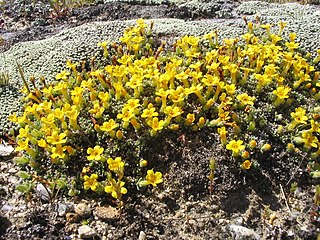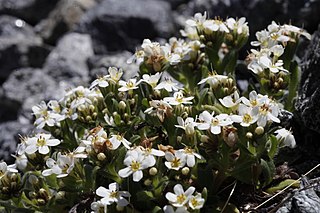
Myosotis monroi is a species of flowering plant in the family Boraginaceae endemic to the South Island of New Zealand. The species was described by Thomas Cheeseman. Plants of this species of forget-me-not are perennial and erect, and have ebracteate inflorescences with cream or white corollas.

Myosotis albiflora is a species of flowering plant in the family Boraginaceae, native to southern Chile and Argentina. This species was described by Joseph Banks and Daniel Solander in Joseph Dalton Hooker's 19th century work Flora Antarctica. Plants of this species of forget-me-not are perennial and have white corollas. It is one of two native species of Myosotis in southern South America, the other being M. antarctica.

Myosotis pulvinaris or the Cushion Forget-Me-Not is a species of flowering plant in the family Boraginaceae, endemic to the South Island of New Zealand. Joseph Dalton Hooker described the species in 1867. Plants of this species of forget-me-not are perennial with a prostrate, compact, cushion habit, short bracteate inflorescences, and white corollas.

Myosotis uniflora is a species of flowering plant in the family Boraginaceae, endemic to the South Island of New Zealand. Joseph Dalton Hooker described the species in 1867. Plants of this species of forget-me-not are perennial with a prostrate, compact, cushion or mat habit, short bracteate inflorescences, and cream to yellow corollas.

Myosotis lyallii is a species of flowering plant in the family Boraginaceae, endemic to New Zealand. Joseph Dalton Hooker described the species in 1853. Plants of this species of forget-me-not are perennial with a prostrate habit, bracteate or partially-bracteate inflorescences, and white corollas.

Myosotis concinna is a species of flowering plant in the family Boraginaceae, endemic to the South Island of New Zealand. Thomas Cheeseman described the species in 1885. Plants of this species of forget-me-not are large, perennial rosettes which form loose tufts or clumps, with ebracteate, erect inflorescences, and yellow corollas.

Myosotis laeta is a species of flowering plant in the family Boraginaceae, endemic to ultramafic areas of the Sounds-Nelson area of the South Island of New Zealand. Thomas Cheeseman described the species in 1885. Plants of this species of forget-me-not are perennial rosettes which form loose tufts or clumps, with ebracteate, erect inflorescences, and white corollas.

Myosotis rakiura is a species of flowering plant in the family Boraginaceae, endemic to southern South Island and Stewart Island/Rakiura of New Zealand. Joseph Beattie Armstrong described the species in 1881. Plants of this species of forget-me-not are perennial rosettes which form loose tufts or clumps, with ebracteate, erect inflorescences, and white corollas with exserted stamens.

Myosotis brockieisubsp. brockiei is a subspecies of flowering plant in the family Boraginaceae, endemic to southern South Island of New Zealand. Lucy Moore and Margaret Simpson described M. brockiei in 1973. Plants of this subspecies of forget-me-not are perennial rosettes which form caespitose tufts or clumps, with ebracteate, erect inflorescences, and white corollas with exserted stamens.

Myosotis goyenii is a species of flowering plant in the family Boraginaceae, endemic to the South Island of New Zealand. Donald Petrie described the species in 1891. Plants of this species of forget-me-not are perennial rosettes which form loose tufts or clumps, with ebracteate, erect inflorescences, and white corollas with partly exserted or fully included stamens.

Myosotis goyeniisubsp. goyenii is a subspecies of flowering plant in the family Boraginaceae, endemic to southern South Island of New Zealand. Donald Petrie described the species M. goyenii in 1891. Plants of this subspecies of forget-me-not are perennial rosettes which form loose clumps, with ebracteate, erect inflorescences, and white corollas with partly exserted stamens.

Myosotis goyeniisubsp. infima Meudt & Heenan is a subspecies of flowering plant in the family Boraginaceae, endemic to central South Island of New Zealand. Heidi Meudt and Peter Heenan described this subspecies in 2021. Plants of this subspecies of forget-me-not are perennial rosettes which form caespitose clumps, with ebracteate, erect inflorescences, and white corollas with fully incluced stamens.

Myosotis traversii is a species of flowering plant in the family Boraginaceae, endemic to the South Island of New Zealand. Joseph Dalton Hooker described this species in 1864. Plants of this species of forget-me-not are perennial rosettes which form tufts or clumps, with ebracteate, erect inflorescences, and white or yellow corollas with partly exserted stamens.

Myosotis traversiisubsp. traversii is a subspecies of flowering plant in the family Boraginaceae, endemic to the northern South Island of New Zealand. Joseph Dalton Hooker described the species M. traversii in 1864. Plants of this subspecies of forget-me-not are perennial rosettes which form tufts or clumps, with ebracteate, erect inflorescences, and white or yellow corollas with partly exserted stamens.

Myosotis traversiisubsp. cantabrica is a subspecies of flowering plant in the family Boraginaceae, endemic to the central South Island of New Zealand. Lucy Moore described M. traversii var. cantabrica in 1961 and Heidi Meudt changed its rank to subspecies in 2021. Plants of this subspecies of forget-me-not are perennial rosettes which form tufts or clumps, with ebracteate, erect inflorescences, and white or yellow corollas with partly exserted stamens.
Myosotis × cinerascens is a hybrid species of flowering plant in the family Boraginaceae, endemic to the South Island of New Zealand. Donald Petrie described M. cinerascens in 1891, and it was later deemed to be a hybrid in 2021. Plants of this forget-me-not are perennial rosettes which form tufts or clumps, with ebracteate, erect inflorescences, and white corollas with partly exserted stamens.

Myosotis petiolata is a species of flowering plant in the family Boraginaceae, endemic to the Hawkes Bay region of the North Island of New Zealand. Joseph Dalton Hooker described the species in 1853. Plants of this species of forget-me-not are perennial rosettes with ebracteate inflorescences and white corollas with exserted stamens.

Myosotis saxatilis is a species of flowering plant in the family Boraginaceae, endemic to New Zealand. Donald Petrie described this species in 1918. Plants of this species of forget-me-not are perennial rosettes with ebracteate inflorescences and white corollas with stamens that are fully included in the corolla tube or sometimes partly exserted.

Myosotis saxosa is a species of flowering plant in the family Boraginaceae, endemic to the North Island of New Zealand. Joseph Dalton Hooker described the species in 1853. Plants of this species of forget-me-not are perennial rosettes with ebracteate inflorescences and white corollas with stamens that are exserted.

Myosotis macrantha or the Bronze Forget-Me-Not is a species of flowering plant in the family Boraginaceae, endemic to the South Island of New Zealand. Joseph Dalton Hooker described the species as Exarrhena macrantha in 1864, and Thomas Cheeseman transferred it to the genus Myosotis in 1885. Plants of this species of forget-me-not are perennial rosettes with ebracteate inflorescences and yellow to dark purple corollas with stamens that are exserted.




















